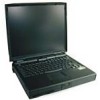Dell Inspiron 7000 Dell Inspiron 7000 Reference and Troubleshooting Guide - Page 34
System Devices
 |
View all Dell Inspiron 7000 manuals
Add to My Manuals
Save this manual to your list of manuals |
Page 34 highlights
Enables the diskette-drive controller. If this option is set to Disabled, the diskette drive is unavailable. This option appears if your computer has a digital versatile disc (DVD)-ROM drive. This option allows you to select a device to provide Moving Pictures Experts Group (MPEG)-2 capabilities. Enabled (the default) selects the internal MPEG-2 card. Disabled selects a PC card. Serial Port lets you map the address of the serial port to avoid address conflicts with other devices or disable the port for security. The default is Auto, and the default base input/output (I/O) and interrupt request (IRQ) address is 3F8 IRQ4. Dell recommends that you retain the default. If for some reason you need to change the serial port address, be careful not to create a conflict with the address of the infrared port. NOTE: If there is a conflict between two or more addresses, an asterisk appears next to the port type in the System Devices menu. Infrared Port lets you map the address of the infrared port to avoid address conflicts with other devices. The default is Disabled. Dell recommends that you retain the default settings. If for some reason you need to change the infrared port address in the Setup program, be careful not to create a conflict with the addresses of the serial port or the parallel port. NOTE: If there is a conflict between two or more addresses, an asterisk appears next to the port type in the System Devices menu. Parallel Port controls whether the computer's parallel port acts as advanced technology (AT)-compatible (unidirectional), Personal System (PS)/2-compatible (bidirectional), Enhanced Parallel Port (EPP)-compatible, or Extended Capabilities Port (ECP)-compatible. Options are Enabled, Disabled, and Auto (the default). The default is ECP. Other possible mode settings are Normal, EPP, and bidirectional. When set to Disabled, you can disable the port and free its assigned LPT address for another device. When set to Enabled, you configure the port settings. The default base I/O address is 378h. If for some reason you need to change the parallel port address and/or direct 2-6 Dell Inspiron 7000 Reference and Troubleshooting Guide















